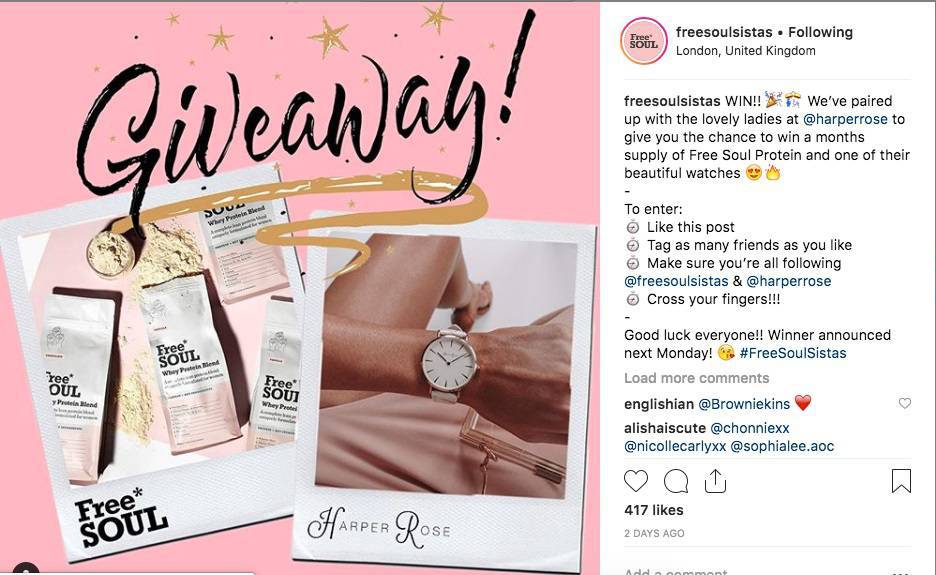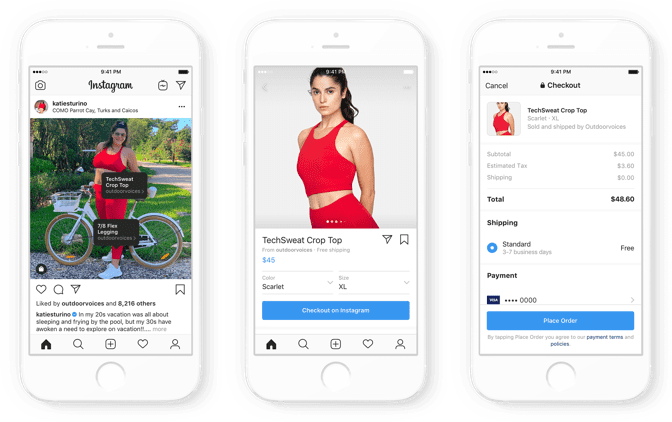
What activities do you need to include in your social media strategy to stay on top of your game in 2020?
We’ll reveal the top 5 strategies you can implement into your current marketing tactics for success throughout the year.
Social Media Strategies in 2020
According to the latest statistics, there are 3.8 billion active social media users as of January 2020. This is a 9% increase compared to the same time last year.
Translated into numbers, last year alone, 321 million new users have joined social media platforms worldwide.
With social media exhibiting an upward trend several years in a row, it’s clear why brands invest a lot of time and effort into creating an effective social media strategy.
Effective social media strategies consist of a series of steps that reflect your goals and what you plan to achieve on social media.
Naturally, for a social media strategy to be effective, it has to take into account the latest social media trends…
1. Use Contests to Get and Stayon the Radar
You’ve surely stumbled upon a social media contest in the past, or maybe even organised one yourself.
Social media contests are a proven way to get the word out, get people interested in what you offer, and boost your followers count.
Over the past couple of years, social media contests have been especially effective when done in a collaboration with an influencer.
In 2020, things are going to change.
As more brands make the shift towards enhanced customer service and two-way communication, contests and giveaways will remain as relevant as ever, but their main goal will no longer centre around increasing the number of likes and followers alone.
Instead, brands are actively starting to use contests as another way to provide something of value to their audience, and not only get on the radar of potential consumers – but stay on the radar as well.

Social media contests can help you:
- Increase brand awareness and remembrance
- Grow your email list
- Drive more traffic to your website/blog/social media platform
- Get to know your audience
- Educate your potential customers
- Increase sales
- Get people to test your products
- Reward your loyal customers
… and more!
Most importantly, you do not need to sell physical products to be able to organise a contest.
Are you a growth specialist helping people that want to start their own business to go from idea to execution? You can offer a free 30-minute consultation call, or free access to your mini-course.
Or maybe you’re a public speaking coach helping people to grow their business through speaking? Why not run a contest and offer some of your resources for free to the lucky winner?
Best of all is, although you give away some of your products/services for free, contests create the perfect opportunity to gain more trust and upsell potential customers when they already have your attention.
You can use several contest formats including, but not limited to: follow to enter, tag a friend to enter, like to enter, comment to enter, share to enter, vote to enter, take a photo to enter, or any combination of these call to actions.
2. Create Deeper Connections with Video
You’ve surely noticed that various social media platforms have started kicking off more features allowing you to share video updates with your audience.
YouTube is huge right now, Instagram encourages its users to share instant updates with Instagram Live, and longer form content with IGTV, and of course, there’s the rising phenomenon – TikTok.
It’s always been widely accepted that visuals drive more engagement, and video enables you to talk to your users directly and make a deeper connection.
It also allows you to share the same information you would otherwise share in written form, in a much more engaging way.
One of the most powerful ways to drive more engagement and get immediate reactions/feedback is live streaming on social media.
Live streams allow you to cover events, pick or announce contest winners in real time or create buzz around a product during its launch phase.
Social media users appreciate the “raw” quality and “realness” of social media videos, so today, everyone can become a content creator, even without the support of a team of professionals.

And of course, many brands who are marketing to younger audiences have already started adopting TikTok.
3. Boost Sales with Augmented Reality (AR)
Social media platforms have made the shift from being a place where people can keep in touch with friends and family to a place where users hang out to stay up to date with the latest developments, get inspired and discover new products.
We all know that social networks influence what people buy online – buyers can easily compare products, read user testimonials and browse new items using social media platforms.
However, over these past couple of years, social networks have started kicking off new features that allow users to shop on social media as well.
Pinterest’s Shop the Look feature allows users to get instantly redirected to the checkout page, where they can immediately turn their inspiration into a purchase.
Similarly, Instagram leads the way allowing brands to not only sell on social, but also to pair social shopping with influencer marketing.
Check out the following Shoppable post:

According to Civic Science’s Trend Adoption Tracker, the number of people who shop through social media “has increased by 8 percentage points since Q4 in 2018”.
At the same time, everyone seems to be talking about AR and how it will shape the future of shopping.
Up until now, a lot of people were visiting stores to see, touch and try on the products before they go back home and order them online, resulting in a complex path to purchase consisting of several touchpoints both in physical and online stores.
This trend among shoppers who are still used to seeing the products before buying them online has been affecting the way retailers do business.
In the future, we can expect that a lot of retailers will transform their brick and mortar stores into showrooms, where people can see and try on the products, and then buy it online. And second, the latest developments in AR will allow customers to get the same experience – online.
In the past, Facebook and Instagram have launched AR filters, allowing users to try on products from selected advertisers to see how they fit before they make a purchase decision.
These AR tools have been limited to the platforms’ early partners in the cosmetics and eyewear industry, including NARS, Mac, Warbly Parker, and Ray Ban.
These AR tools are still in the testing phase and are limited to some advertisers.
However, it’s now possible for anyone to create their own filters using Spark AR Studio, so go ahead and download the app to get acquainted with what it can do, and see if there is a way for you to leverage AR to make your consumers’ online experience more engaging and fun.
For more information on the current use of AR on social media, as well as the benefits brands can expect to see from incorporating AR into their branded experiences.
4. Get on the Micro-Influencer Marketing Bandwagon
Despite what naysayers claim, influencer marketing is on the rise, and is expected to grow even more in 2020.
To stay relevant and get discover by new audiences, brands need to start partnering up with content creators who are loved and trusted by their communities.
But how can small brands afford to pay influencers?
This is a common objection raised by businesses who still equate influencer marketing to celebrity endorsements, while in fact, an influencer can be even someone with 1000 followers.
There are 5 influencer tiers: Nano, Micro, Mid-Tier, Macro and Mega influencer.
You can see the number of followers an influencer needs to belong to a particular tier on the infographic below:
Lately, many brands have started stepping away from mega influencers and instead, they’ve started to collaborate with smaller creators who have an audience between 10K and 100K followers.
Unlike mega influencers, who have such a large following that they’ve reached a celebrity status, micro influencers have a more genuine relationship with their community and as a result they have a lot of true fans that trust them and their judgement.
One great example that illustrates how successful a strategy based on micro-influencer collaborations can be is Swedish watchmaker Daniel Wellington. The brand’s strategy centres around partnering with micro influencers from all across the world.
The results?
Daniel Wellington has become one of the most well-known brands on social media.
Daniel Wellington are also encouraging their customers to share pictures of their Daniel Wellington timepieces to get a chance to be featured in their #DWPickoftheDay this is a great example of a contest where the brand doesn’t offer a physical product, and still manages to incentivise their followers to enter by offering them exposure.
5. Go Beyond Twitter, Facebook and Instagram
The key to staying relevant is keeping up with your audience, their interests and habits.
One of the things that you need to track are the social media platforms where your target audience spend the most of their time.
Although there are a lot of new social media platforms appearing, and it’s impossible for you to be present everywhere, you need to assess which platform has the biggest potential based on your line of business and audience.
For example, a lot of brands focus on the most widely known social media networks: Twitter, Facebook and Instagram, while overseeing other networks like LinkedIn, Pinterest and as of recently, TikTok.
Depending on your brand and what you sell you might want to consider experimenting with some other platforms which might not be that popular in terms of advertising but may prove to be very effective for you and help you reach new, engaged audiences.
Pinterest, for example, is a great platform for interior design companies, since a lot of people browse Pinterest for home décor inspiration.
TikTok, on the other hand, has an algorithm that allows for a large organic reach, even if you’re just starting out.
LinkedIn has also rolled out some new features, including banners and CTAs and is a great place for brands who are looking to provide extra value to their audience, since LinkedIn’s algorithm is tailored in favour of long, informative content.
That’s why we’ve been seeing a lot of B2B and SaaS brands focusing on LinkedIn as the core of their social media strategy.
Whatever social media platform you use, you need to talk to your audience and make the shift towards a two-way communication. You can do this by using videos, organising contests, throwing events, or simply by sliding into your consumers’ DMs.
Final Thoughts
The social media landscape is changing every day, and with new features kicking off and new social media platforms gaining popularity it can be hard to develop social media strategies.
However, if we take a better look, all these changes and features have one thing in common: they’re developed to help brands drive more engagement, start conversations and provide more value to their customers.
So if we have to sum this up and give you a single tip to follow in 2020, it’s this:
Be creative, but do not follow trends blindly, and instead, invest in those things that are in line with your brand and are appreciated by your audience.
If you are looking for someone to help you bring your business brand or social media marketing, We’d love to chat. Shoot us a message!




Comments +